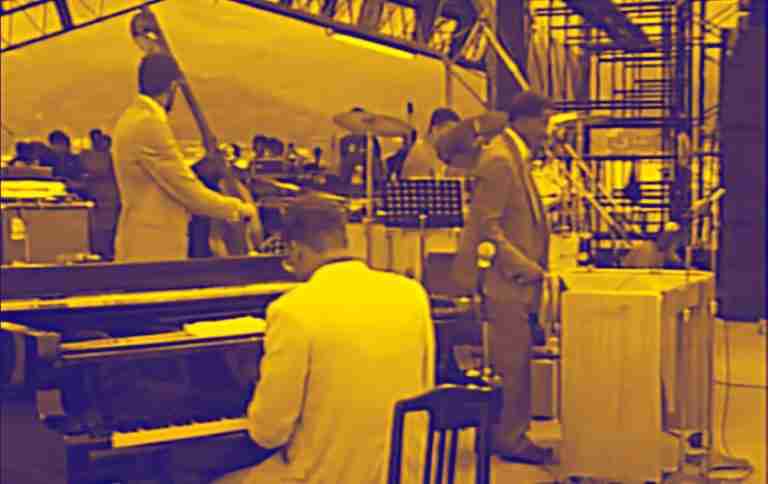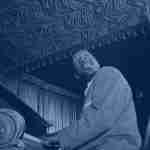Maiden Voyage is a classic jazz standard that all improvisers will encounter at some point in their musical journey. With only four chords, beginners tend to gravitate toward this Herbie Hancock masterpiece because it seems like it would be an “easy” jazz tune…
While it’s true that there are only four chords and that the form is relatively simple to navigate, calling this a beginner jazz tune is quite a leap.
Like Modal Jazz, the jazz legends did not encounter this tune until after dealing with the fundamental challenges of jazz…
At this point (1965), they already had a firm grasp on:
So to call it an easy tune or a beginner jazz standard is not really true and to understand both the chords and how to solo over them in a coherent way takes a bit of study.
But not to worry…
Today we’re going to give you all the tools you need to understand, hear, and play Maiden Voyage like a pro.

We’ll start out by getting into the chord progression and the form. Then we’ll do a little deep-dive into Sus chords. After that, we’ll take a look at the voicings Herbie Hancock uses on these Sus chords along with the rhythm.
And then, after laying the groundwork for the tune, we’ll deconstruct Bobby Hutcherson’s perfect solo on Maiden Voyage, detailing a bunch of soloing tactics that you can start using today.
We have a lot to cover, so let’s get into it…
Maiden Voyage: Chord Changes & Form
The Form of Maiden Voyage is very simple…
For its 32 bars, It uses the most common form in jazz, AABA, and it only has four chords – the A Section has two chords and the B Section has two chords.
But, contrary to popular belief and The Real Book, these chords are not all the same…
Listen to this incredible version of Herbie Hancock playing Maiden Voyage with Bobby Hutcherson and keep in mind there is an intro before the AABA from starts…
Three of the four chords are Sus chords, while if you listen closely to the second chord in the Bridge, you should hear that it’s actually a minor chord (You can of course think of Db minor or C# minor. The later is my preference).
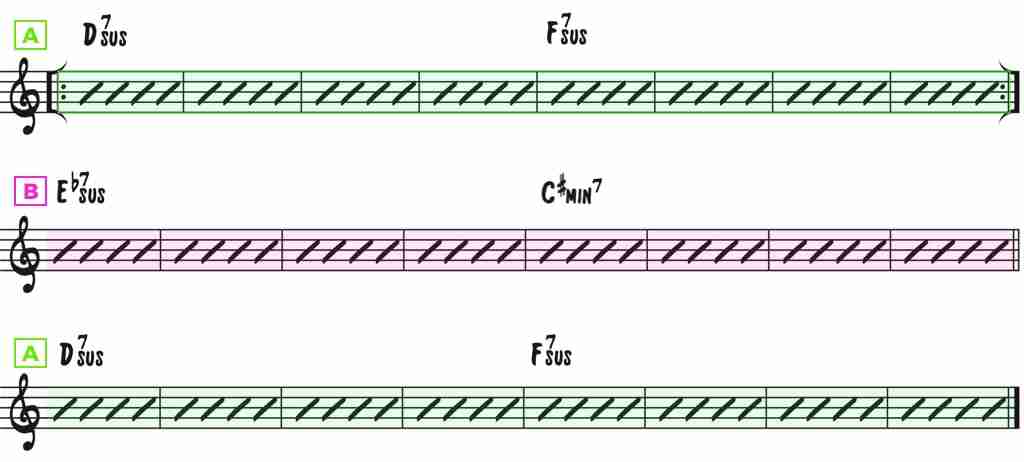
Now, Sus chords have a unique sound and they are what give this tune a wide open sound.
But what exactly is a Sus chord?
What is a Sus Chord?
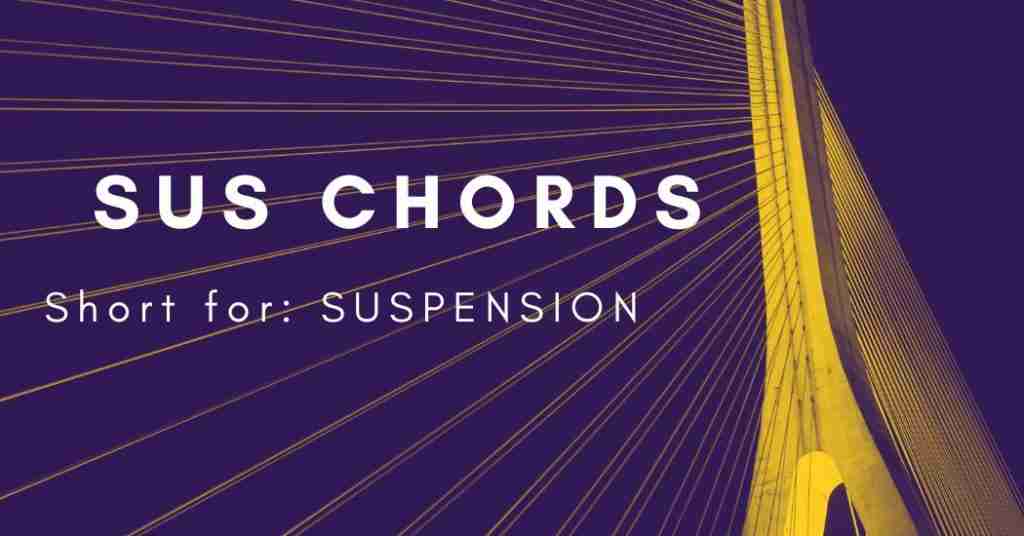
The term Sus is actually an abbreviation…
So if you see the symbol D7 Sus, what this actually means is a D dominant 7th chord with a suspended fourth because “Sus” is short for “suspended”.
Yes, you can suspend other chord-tones like the 2nd/9th, but in general, in jazz, D7 Sus refers to the 4th being suspended unless otherwise notated…
And the easiest way to understand what this idea of suspension means is to look at the voice leading of a ii V.
In a standard ii V7 from Major Harmony, when moving from ii to V7 the 7th of the ii chord moves down chromatically to the 3rd of the V7 chord, the note G moves to F#.
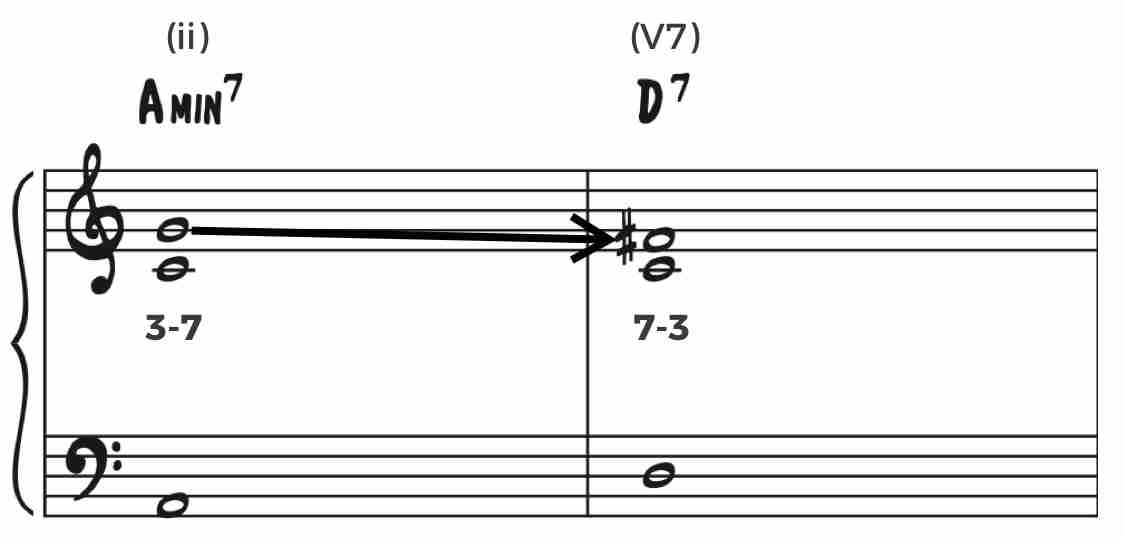
But with a Sus chord, the 7th of the minor chord (G) does not move down to the 3rd (F#), it instead remains on the same pitch.
So, the 4th ends up in a suspended state, NOT resolving to the 3rd, which is why it’s called a Sus Chord, short for suspended 4th chord.
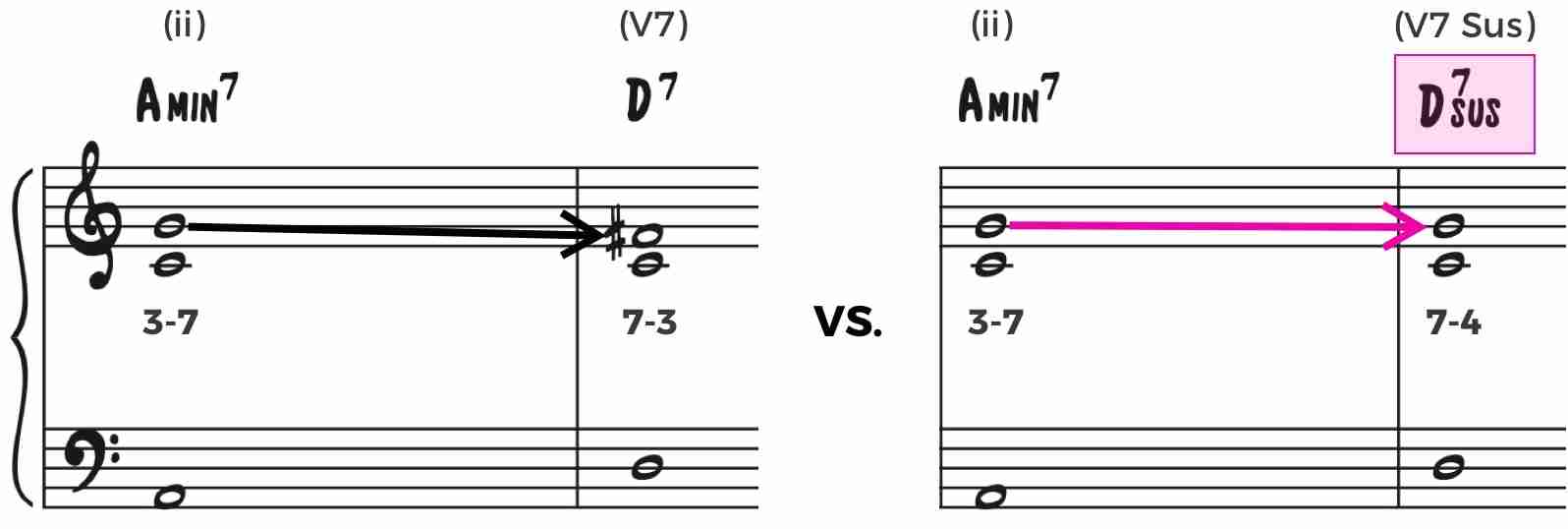
Next we’ll talk a little bit about the consonant notes on a Sus chord…
So what do you play over a sus chord?
Understanding the theory behind why a Sus chord is called Sus is great and all, but what do you actually play over them?
If we look at a normal V7 chord compared to a Sus chord, it would seem as though the 3rd on a Sus chord would be an “avoid note” because it’s not present within the basic chord and it’s replaced with the suspended 4th…
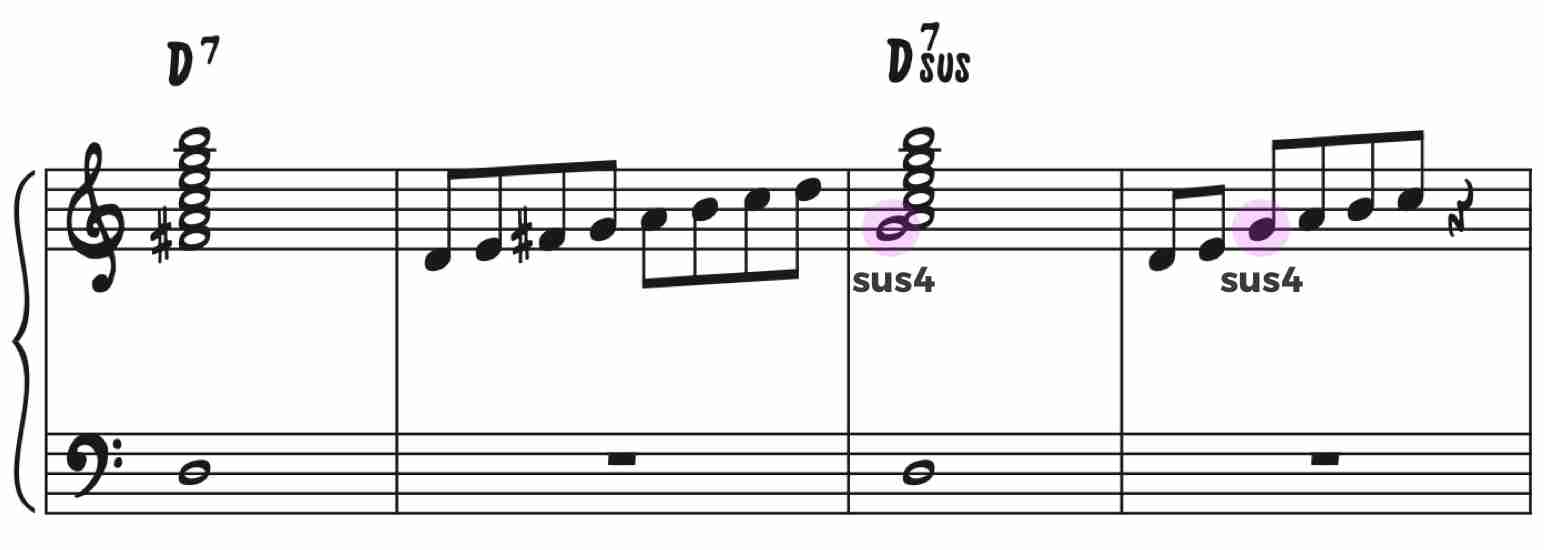
Above, I’ve shown you the chords all the way up to the 13th, and I’ve reordered the notes into a linear structure, a scale, next to them so you can very easily see what’s going on…
But treating the 3rd as an avoid note is actually not the right thing to do…
In reality, because there is no 3rd in the chord, BOTH a minor and major third are consonant possibilities.

Sus chords don’t close harmony or melody, they open them
So playing over Sus chords, you can treat them just like a normal V7 chord, with a couple more options…
- The 4th will sound consonant because there is no 3rd for it to clash with
- Both the major 3rd and minor 3rd can sound consonant in your lines
These extra options on a Sus chord give you more possibilities when you solo over them. You don’t have to worry about the sound of the 4th clashing with the major 3rd, and the minor 3rd will sound good as well.
Next, let’s look at how to voice the Sus chords at the piano using triads…
Piano Voicings on Sus Chords
Rather than just playing a chord in stacked 3rds and replacing the major 3rd of the chord with the Sus 4, jazz musicians voice the chords – they choose which notes from the chord they want to play, and arrange them in a specific order to create the particular character they desire for the chord.
And a great way to understand how Sus chords are often voiced is to first realize how they are sometimes notated…
Instead of D7 Sus, sometimes a Sus chord will be notated as a specific minor chord over a root note…
This notation uses the related ii minor chord over the root of the V7 chord, and by related I mean the ii chord that would pair with the dominant chord if it were a ii V progression.
So an alternate notation for D7 Sus that you might occasionally see will be A minor (the ii chord) over D (the root of the V7 chord)…
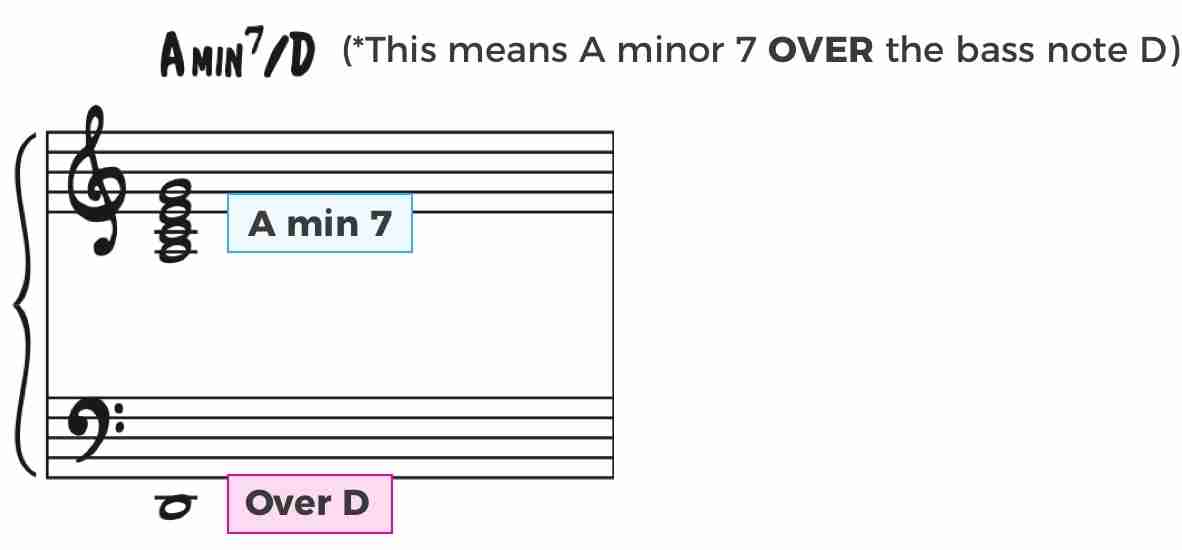
So that is one very effective way to voice Sus chords, by using the ii minor chord (A minor) over the V7 root (D).
Now, if you closely look at the structure of A minor, you should notice that a C major triad sits right inside of it.
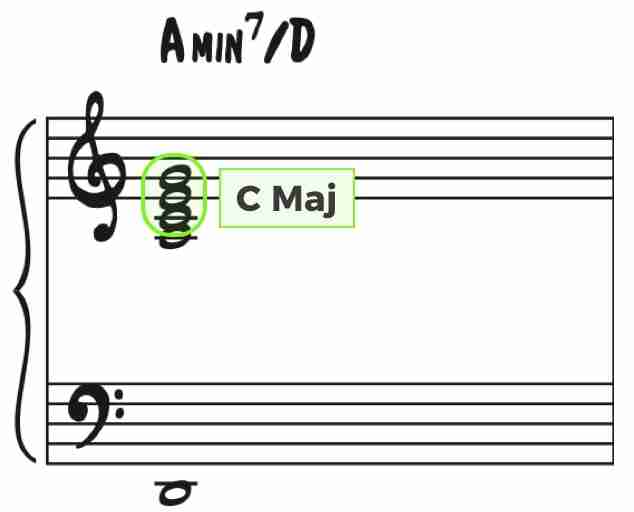
In relation to D7, this is a major triad built from the dominant 7th and it gives you the b7-9-11 of the dominant chord, and that 11th is really the Sus4 in the chord.
And this is another very common way to voice Sus chords…
You take that b7 triad (C major triad) and put it over the root (D) of the Sus chord in any inversion, and then double the lowest pitch of the triad inversion (keep in mind that the lowest note, G in this case, could easily be played as an A to use the ii over V7 root idea instead).
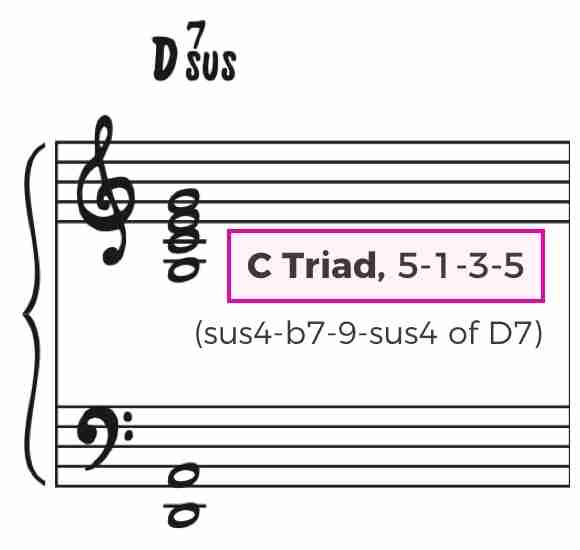
And these are the type of Herbie Hancock piano voicings in Maiden Voyage. Although he may modify or switch up the exact notes, these are the general concepts used – Either use the ii minor (A minor) over the V7 root and 5th (D and A), or use the triad embedded within that minor chord (C major triad).
In the A Section you can use this type of voicing for both the D7 Sus and the F7 Sus.
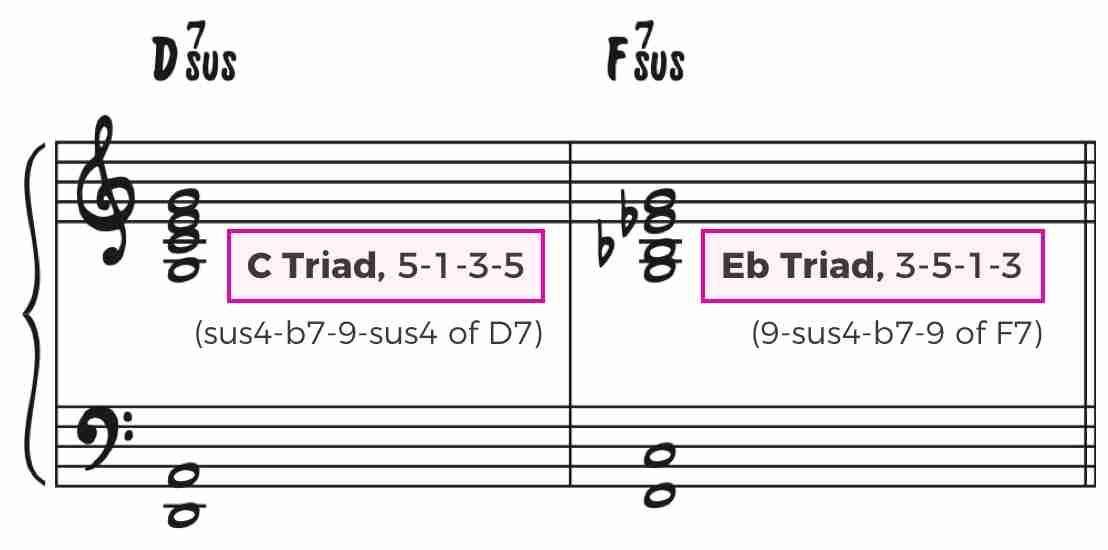
Notice how the inversion of the triad changes to suit the voice leading needs, but that it’s still just the b7 major triad over the root of the chord.
Then, in the B Section, you can voice the Eb7 Sus using the same tactic.

Now let’s talk about the comping rhythm in Maiden Voyage and how to learn to hear it…
Hearing The Rhythm
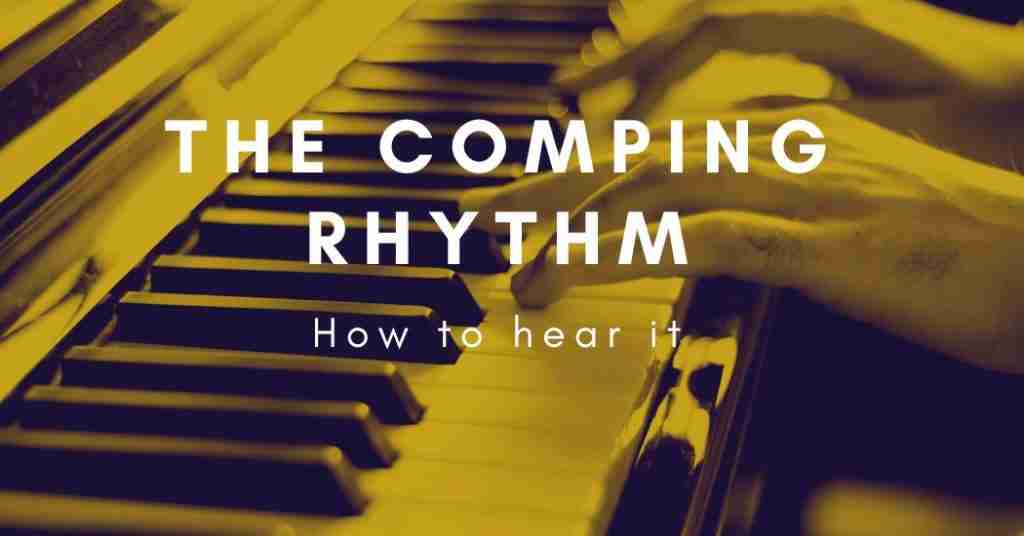
Hearing the comping rhythm in Maiden Voyage is not easy…
In fact, I can remember it tripping me up a ton when I was younger and looking back on it, I wish someone had showed me the rhythm and walked me through an easy way to hear it.
So let’s do that for you…
Here is the comping rhythm written out and repeated several times so you can hear it clearly…

Now, if you remove the ties and then sing along with it a bunch of times, you’ll start to internalize how Herbie has put this rhythm together.

Once you study the rhythm with no ties in it, add the ties back in and sing along with it, but keep hearing the untied version in your head. So listen to the real version below with this in mind…

Repeat this process many times and soon this rhythm will make a lot more sense to you and will be easy to follow.
Bobby Hutcherson’s Solo on Maiden Voyage
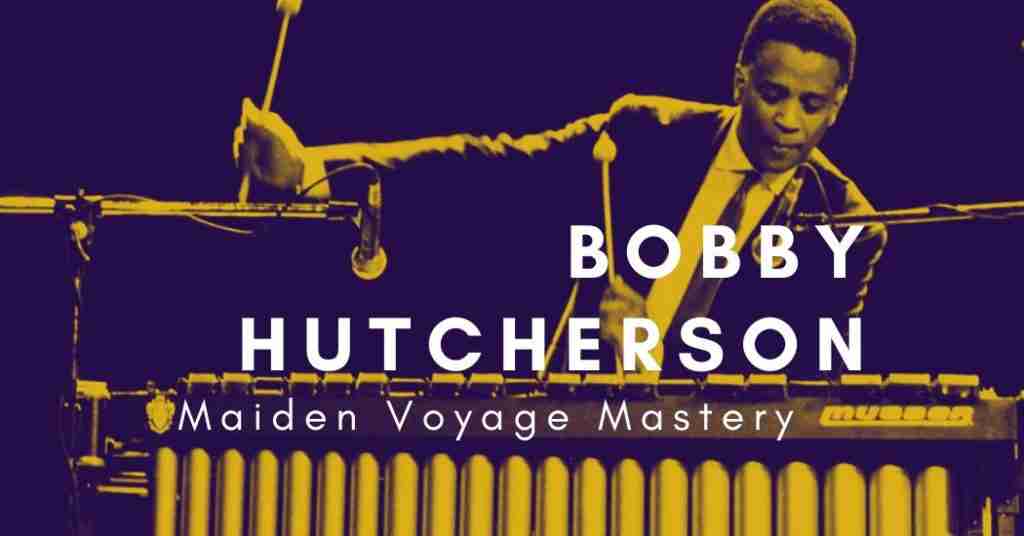
Alright, you know the form of the tune, and you have a grasp on the chord changes and Sus chords…
We’ll now look at what master vibraphonist Bobby Hutcherson plays on these changes.
Here is a transcription of his solo on Maiden Voyage and it’s a masterpiece.
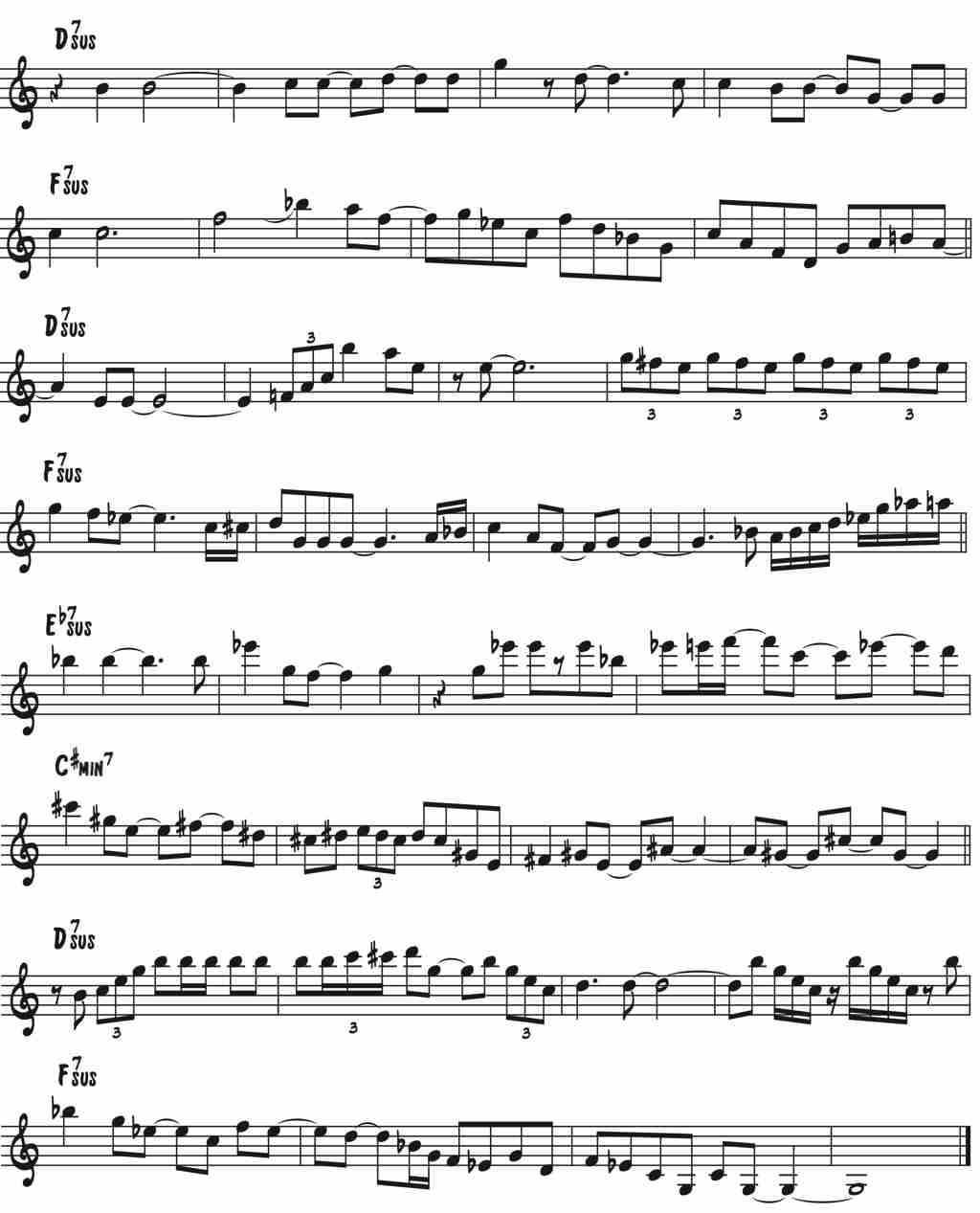
Not a wasted note…his phrasing and lyricism come though beautifully, as he effortlessly navigates the changes.
Now playing a solo like Bobby takes a lifetime of study, but there are a ton of things that we can learn from his solo…
Bobby Hutcherson’s Soloing Tactics
There are many soloing tactics that you might take from Bobby Hutcherson’s solo on Maiden Voyage, but we’ll highlight some of the easiest ones to adopt into your playing fast.
1. Create cells that emphasize the Sus sound
Have a listen to the very first line of Bobby’s solo…

He plays just perfectly here and really highlights the Sus sound. So how might we take this technique?
First, we’re going to create a structure that emphasize the sus note, the 4th by isolating a few of the consonant notes. We’ll take the root, the 4th, the 6th, and the dominant 7th…

And as you can see, if we rearrange these starting from the Sus note, G, this can be thought of as a 4 note cell or scale from the Sus note (G) which from that note would be 1-3-4-5.
Once we create the 4 note cell, then we’ll add the root on top of it…and then move up and down it – you can now see how the result is a condensed version of the entire phrase that Hutcherson plays…

Often beginners try to use a whole scale when so much more can be found in smaller structures
A cell, or if you’d rather think of it as a 4 note scale, like this can be a powerful melodic tool over Sus chords.
Try using this cell, the 1-3-4-5 from the Sus note like Bobby does, or coming up with your own.
2. Use intervals of a 4th and highlight the 4th chord-tone
Take a listen to this line that Bobby Hutcherson plays over F7 Sus…

Notice that he’s essentially treating the chord as a standard dominant chord but doing two things in addition that he might not do on a regular dominant chord…
First, he starts out the line with intervals of a fourth…

And second, he emphasizes the 4th (same as the 11th) chord-tone (the suspended 4th) in his line…

These are two soloing tactics over Sus chords that you want to steal – adding the intervals of a fourth helps give you that wide open sound in your lines, while emphasizing the 4th highlights the Sus chord color.
Try to start using these right away, as they’re quite easy to add into your playing.
3. Learn to Use Both Major & Minor 3rds
Most people tend to treat a Sus chord like a dominant chord because it actually is a variation of a dominant chord, however, don’t forget that in a modal context that uses Sus chords, the minor 3rd is also available to you.
Most players do not use this too often, but of course, Bobby Hutcherson makes use of it.
Take a listen to this line and try to hear how he treats the first part of the line differently than the later…

In the first part, he uses the minor 3rd, F, treating the chord as a D minor 13 chord, and then in the second part of the line, he uses the major 3rd, F#, treating like a dominant chord (with the addition of emphasizing the 4th).

It’s not easy to use the minor 3rd because it’s more difficult for most people to hear. Take a listen to this as I play a Sus chord with a phrase that focuses on the minor 3rd…
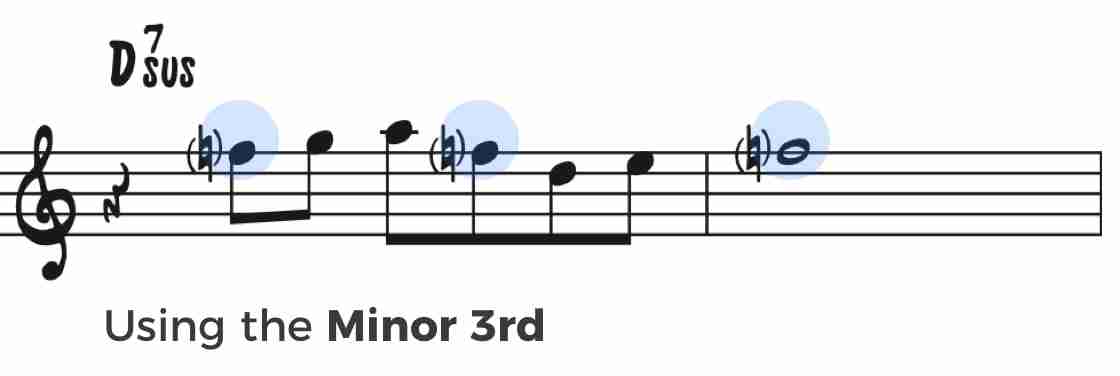
Now listen to he same phrase with a major 3rd…

Surprisingly, they both work, even though the use of the minor 3rd can sound a little less natural…
Experiment with using both and learn to hear both in the context of your lines. Gradually, you’ll remember that you have both of these sounds available to you over Sus chords.
4. Use 1235 cells in interesting ways
The 1235 cell is a classic structure that John Coltrane loves to use, especially on tunes like Giant Steps.
But this powerful little unit can also be great for crafting interesting melodic motifs, as well.
Listen to this line in Bobby’s solo and try to hear how he’s using a 1235 cell, although you probably won’t get it at first because it’s out of order…

Okay, let me explain a way that can give you some insight into this line…
First, let’s take 1235 of Eb and write out the 1235 unit starting from each of the notes…

And then next, we’ll change the order, so 1235 will become 3521, and we’ll apply this same transformation to the other groups, and we get this…
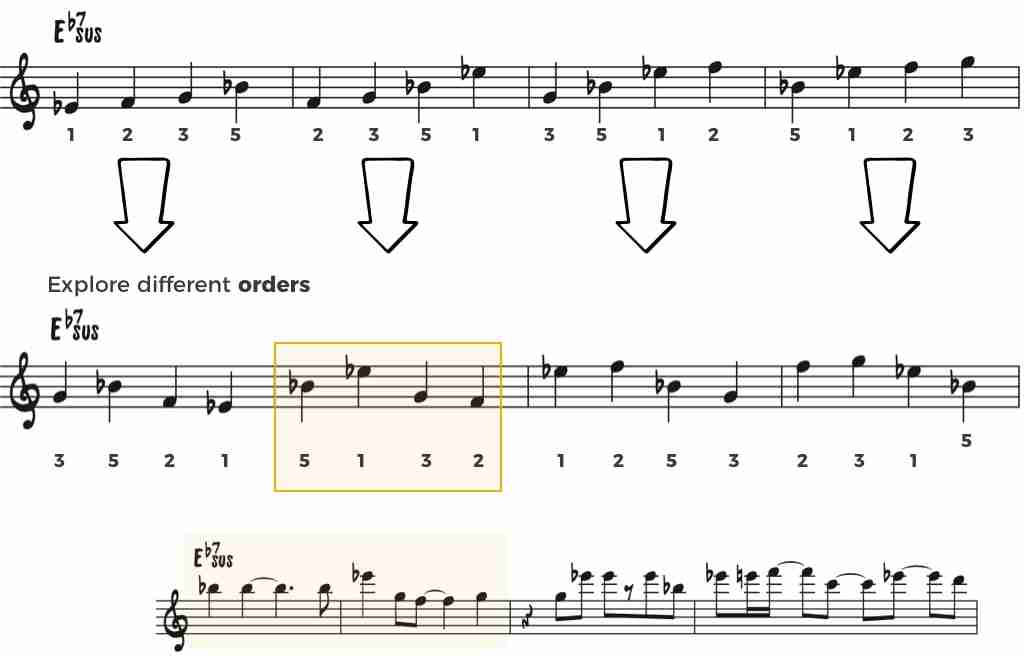
If you look closely, you can see that the highlighted group forms the foundation for Bobby’s little motif – It’s a 5132 cell that he then takes and develops.
Obviously he’s not doing this math in his head and you could never improvise while thinking about things like this.
But, he’s researched and practiced the various 1235 groupings that he likes, learned to hear them, and then he’s taken them into his own playing.
You can do this too! Simply take any grouping that catches your ear and start using it. It’s that easy.
5. Nail the Minor Chord
So if you’ve played Maiden Voyage out of The Real Book before, then you probably think that every chord in the tune is a Sus chord because that’s how The Real Book and many other charts notate every chord…
But the second chord on the Bridge, as we’ve talked about before, is not a Sus chord. It’s actually minor. If you listen, you can hear the minor quality.

And if you look at any famous solo over this chord, they all treat the chord as minor and not dominant (Remember, a Sus chord is type of dominant chord).
You can see here that Bobby emphasizes a C# minor triad and other minor language…
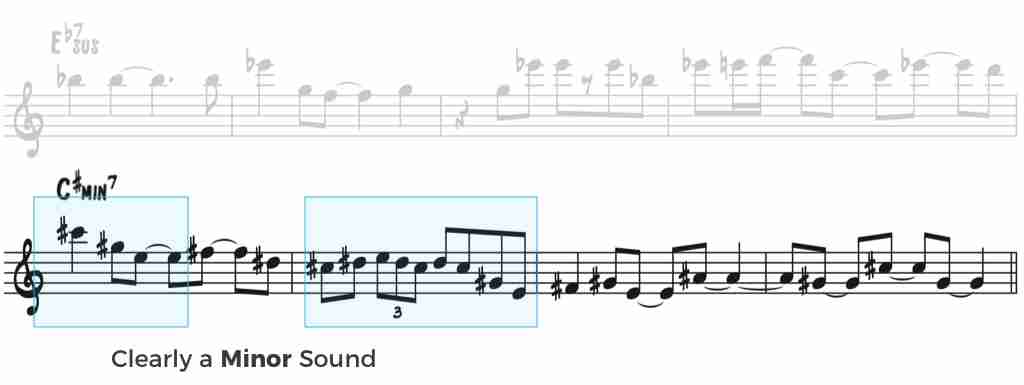
Now, over this chord in this particular setting, the natural 13th is an especially beautiful note. Just have another listen to Bobby’s line here and you’ll know exactly what I’m talking about.

When it comes to this chord, make sure you don’t fall into the trap of thinking it’s a Sus chord. Most charts get this wrong, so make sure you nail the minor quality.
6. Use your voicing knowledge to utilize key arpeggios
If we go back a bit to when we talked about how a Sus chord is sometimes notated and how Herbie Hancock voices them, this will give you some insight into why certain arpeggios are so effective over Sus chords…
Do you remember that sometimes a Sus chord is notated as the related ii minor chord, over the root? And do you remember how Herbie used the triad from the b7 in his voicings?
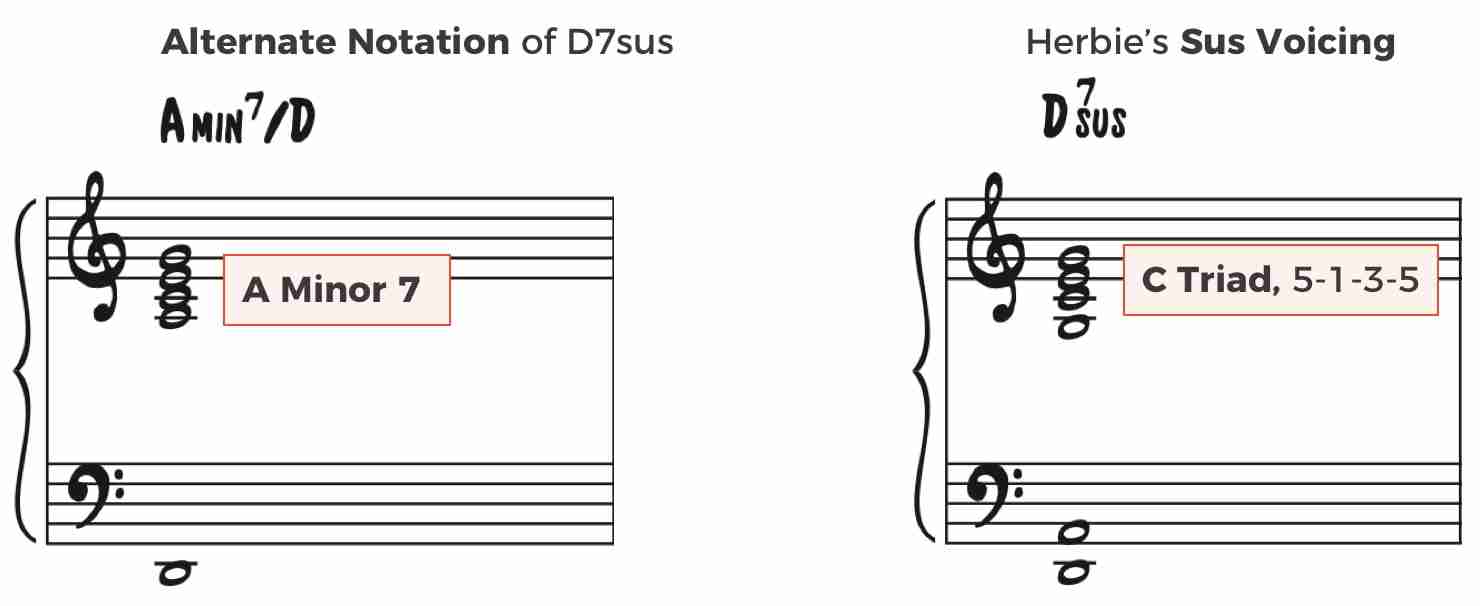
So knowing this, it makes sense that the two most common arpeggios to use are based upon the related ii minor and the major structure from b7.
Over D7 Sus, this would be A minor and C major, and over F7 Sus, we could use C minor and Eb major.
And if we look at Bobby’s line here, it’s no surprise what arpeggios we find….
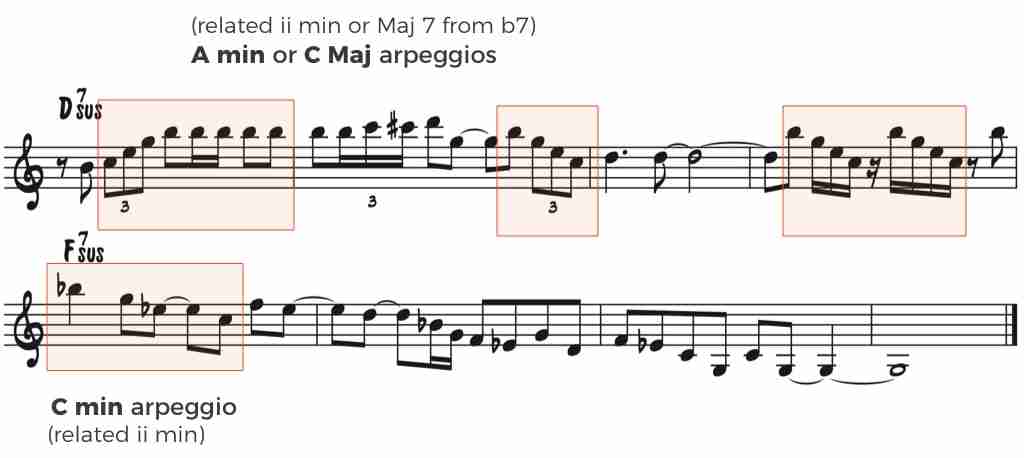
You can think of these as 3-5-7-9 of A minor, or 1-3-5-7 of C major. In both cases, they’re based upon the structures we talked about.
So, spend some time and visualize through these relationships so you can easily conjure up the related ii minor and the major chord from the b7 without any effort.
Maiden Voyage is Easy?
Personally, I think it’s a bit crazy that in jazz education today, Maiden Voyage has become a beginner jazz tune…
There’s so much to know to play over it. You have to:
- Understand what Sus chords are, how they’re constructed and what to play over them
- Understand the comping rhythm and be able to hear it
- Understand how to create melodic lines over non-traditional harmony
And these are just a few of the challenges that this Herbie Hancock classic presents us with! It’s by no means an easy tune, but with everything we went over today, you should be well on your way to tackling it like a pro.
When you go back through this lesson, make sure you…
- Study Sus chords – Work on the piano voicings and practice playing them. Learn to hear what a Sus chord sounds like with zero effort.
- Learn to use cells – Bobby Hutcherson uses cells in a unique way to create his melodies. Go back and really seek to understand how he’s using them in his solo.
- Make use of 4th intervals & the Sus 4 note – Intervals of a 4th and using the Sus 4 chord-tone add a lot to playing over Sus chords.
- Learn to hear minor 3rds on Sus – The minor 3rd is tricky to hear over Sus chords, but if you work on it, you’ll be able to add it to your color palette as an improviser.
- Nail the minor chord – Remember that the second chord of the Bridge is not a Sus chord, despite what many charts say. Make sure to highlight the different quality of this chord in your solos.
- Use your voicing knowledge – The more you know about how a chord is constructed, the better understanding you’ll have to play over it. Take your voicing knowledge and use it when you improvise.
Maiden Voyage has become a jazz standard for several reasons…it’s catchy, different, and a lot of fun to play!
Take the concepts, lines, and ideas we explored today and see how you can apply them in your own creative way, and in time, Maiden Voyage is bound to become one of your favorite tunes.
